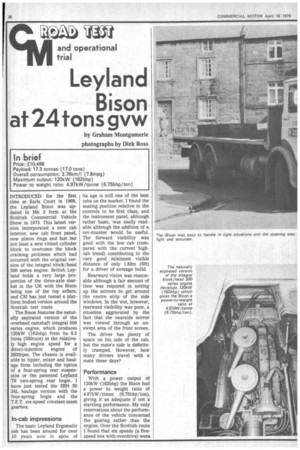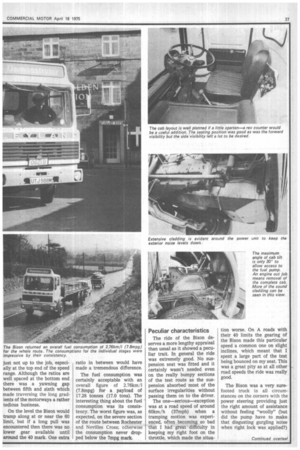Co 'AO A 41.111 and operational trial
Page 38

Page 39

Page 40

If you've noticed an error in this article please click here to report it so we can fix it.
Leyland Bison at 24 tons gvw
by Graham Montgomerie photographs by Dick Ross
INTRODUCED for the first time at Earls Court in 1968, the Leyland Bison was updated to Mk 3 form at the Scottish Commercial Vehicle Show in 1973. This latest version incorporated a new cab interior, new cab front panel, new piston rings and last but not least a new ribbed cylinder block to overcome the block cracking problems which had occurred with the original version of the integral block/head 500 series engine. British Leyland holds a very large proportion of the three-axle market in the UK with the Bison being one of the top sellers, and CM has just tested a platform bodied version around the Scottish test route.
The Bison features the naturally aspirated version of the overhead camshaft integral 500 series engine, which produces 120kW (162bhp) from its 8.2 litres (500cuin) at the relatively high engine speed for a direct-injection engine of 2600rpm. The chassis is available in tipper, mixer and haulage form including the option of a four-spring rear suspension or the patented Leyland T6 two-spring rear bogie. I have just tested the 3BN 50 24L haulage version with the four-spring bogie and the T.E.T. six-speed constant-mesh gearbox.
In-cab impressions The basic Leyland Ergomatic cab has been around for over 10 years now in spite of its age is still one of the best cabs on the market. I found the seating position relative to the controls to be first class, and the instrument panel, although rather basic, was easily readable although the addition of a rev-counter would be useful. The forward visibility was good with the low cab (compared with the current highcab trend) contributing to the very good minimum visible distance of only 1.83m (6ft) for a driver of average build.
Rearward vision was reasonable although a fair amount of time was required in setting up the mirrors to get around the centre strip of the side windows. In the wet, however, rearward visibility was poor, a situation aggravated by the fact that the nearside mirror was viewed through an unswept area of the front screen.
The driver has plenty of space on his side of the cab, but the mate's side is definitely cramped. However, how many drivers travel with a mate these days?
Performance
With a power output of 120kW (162bhp) the Bison had a power to weight ratio of 4.97kW/tonne (6.75bhp/ton), giving it an adequate if not a startling performance. My only reservations about the performance of the vehicle concerned the gearing rather than the engine. Over the Scottish route I found that six speeds (a fivespeed box with overdrive) were just not up to the job, especially at the top end of the speed range. Although the ratios are well spaced at the bottom end there was a yawning gap between fifth and sixth which made traversing the long gradients of the motorways a rather tedious business.
On the level the Bison would tramp along at or near the 60 limit, but if a long pull was encountered then there was no tower gear available until around the 40 mark. One extra ratio in between would have made a tremendous difference.
The fuel consumption was certainly acceptable with an overall figure of 2.76km/1 (7.8mpg) for a payload of 17.28 tonnes (17.0 tons). The interesting thing about the fuel consumption was its consistency. The worst figure was, as expected, on the severe section of the route between Rochester and Nevilles Cross; otherwise the consumption never dropped below the 7mpg mark. Peculiar characteristics The ride of the Bison deserves a more lengthy appraisal than usual as it showed a peculiar trait. In general the ride was extremely good. No suspension seat was fitted and it certainly wasn't needed even on the really bumpy sections of the test route as the suspension absorbed most of the surface irregularities without passing them on to the driver.
The one—serious—exception was at a road speed of around 60km/h (37mph) when a tramping motion was experienced, often becoming so bad that I had great difficulty in keeping my right foot on the throttle, which made the situa tion worse. On A roads with their 40 limits the gearing of the Bison made this particular speed a common one on slight inclines, which meant that I spent a large part of the test being bounced on my seat. This was a great pity as at all other road speeds the ride was really good.
The Bison was a very surefooted truck in all circumstances on the corners with the power steering providing just the right amount of assistance without feeling "woolly" (but did the pump have to make that disgusting gurgling 'noise when right lock was applied?) Damp conditions The braking tests were carried out as usual at MIRA, in unhelpful weather with frequent snow showers making the road surface treacherous in parts. These conditions made the Bison's braking even more impressive than the bare figures show. The stopping distance from 40mph was 34.8m (114ft 4in), accomplished with the offside wheels in pools of water, which accounted for the truck getting slightly out of line during this part of the test. With a dry surface I think a stopping distance from this speed of under 30m (around 100ft) would be well within the Bison's capabilities.
The park brake comfortably exceeded the required performance recording 0-34g on the Tapley Meter.
On the hills Initially I was apprehensive about the Bison's ability to cope with the Ridsdale and Riding Mill sections of the Scottish test route, but when the truck coped with a restart on the 1 to 6 test hill at MIRA I thought all would be well. And so it proved—although the crawler first gear was necessary on a number of occasions.
The hills on the road were climbed in rather a ponderous manner emphasising the shortage of available ratios. The Carter Bar climb and the long haul out of Moffatt to the Devil's Beef Tub were both climbed using third gear. Every time I tried for fourth the Bison would pull it only for around 100m, necessitating a rapid down-change.
However, in third the truck would accelerate pushing the engine on to the governor— but it would just not pull the next higher gear. Thus the time up Carter Bar, while not being particularly slow, is an indictment of the gearing in particular rather than the complete truck.
Accessibility Access to the dip stick and header tank for routine "level checking" is carried out through the removal panel in the cab itself. The dipstick is hardly the easiest part of the truck to get at, requiring a driver with a long arm.
Although the cab tilts, the maximum angle is only 30 deg and this involves some spanner work including the complete removal of the driver's seat, which takes some time. The tilt is provided for maintenance on the fuel pump, for example—an engine change means a complete cab removal.
Summing up I was impressed with the Bison as an extremely useful and workmanlike 24-tonner. The fuel consumption was reasonable for this weight without being outstanding and the truck, in general, handled very well.
My only real complaint was the gearbox. As I mentioned the shortage of ratios was acute on many occasions. Leyland does, in fact, offer a tenspeed gearbox, but rather surprisingly this is available only on the mixer chassis.
It does, however, mainly increase the ratio options in the lower speed range, which the haulage Bison does not really need.
The chassis price of the 33N 50 24L Bison as tested was £9,930 with the 8.2m(27ft)long Cravens Homalloy platform body costing a further £568.








































































































































